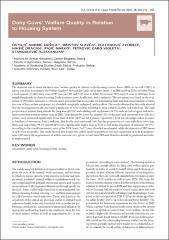| dc.description.abstract | The objective was to assess the dairy cows’ welfare quality in relation to the housing system: loose (LHS) vs. tie-stall (THS). A
survey was done according to the Welfare Quality® Protocol for Cattle on 16 dairy farms (7 in LHS and 9 in THS) in Serbia. From
a total number of 4833 dairy cows (2392 cows in THS and 2441 cows in LHS) 551 cows in THS and 470 cows in LHS have been
sampled randomly for clinical scoring (body condition score, health state, and cleanliness). The assessment was based on the evaluation
of 29 welfare measures, 12 criteria, and 4 principles that are relevant for determining risks and final categorization of farms
into one of four welfare categories: not classified, acceptable, enhanced, and excellent. The results obtained in this study showed
that the housing system affected many parameters of cows’ welfare referring to their comfort, health, and behaviour. The high
proportion of animals lying outside the lying area (49.5%) and colliding with equipment (16.7%) indicate lack of space and movement
restriction as major welfare risks in THS. Consequentially, scores for injuries (AI=45.8 points) and emotional state (ES=43.2
points) were estimated significantly lower than in LHS (58.9 and 60.4 points respectively). LHS has advantages when it comes
to freedom of movement, body condition, skin health, and emotional state, but the proportions of cows with dirty lower legs,
flank, and upper legs (93.4% and 80.66%) were significantly higher than in THS as well as the frequency of lameness (31.4%).
According to the overall assessment, most of the LHS farms (5 of 7) were classified as enhanced, while the majority of THS farms
(6 of 9) were acceptable. This study showed that despite the welfare quality parameters were not exceptional in both housing systems,
LHS meets the requirements of welfare assurance to a greater extent than THS and therefore should be promoted and widely
implemented. | en_US |

